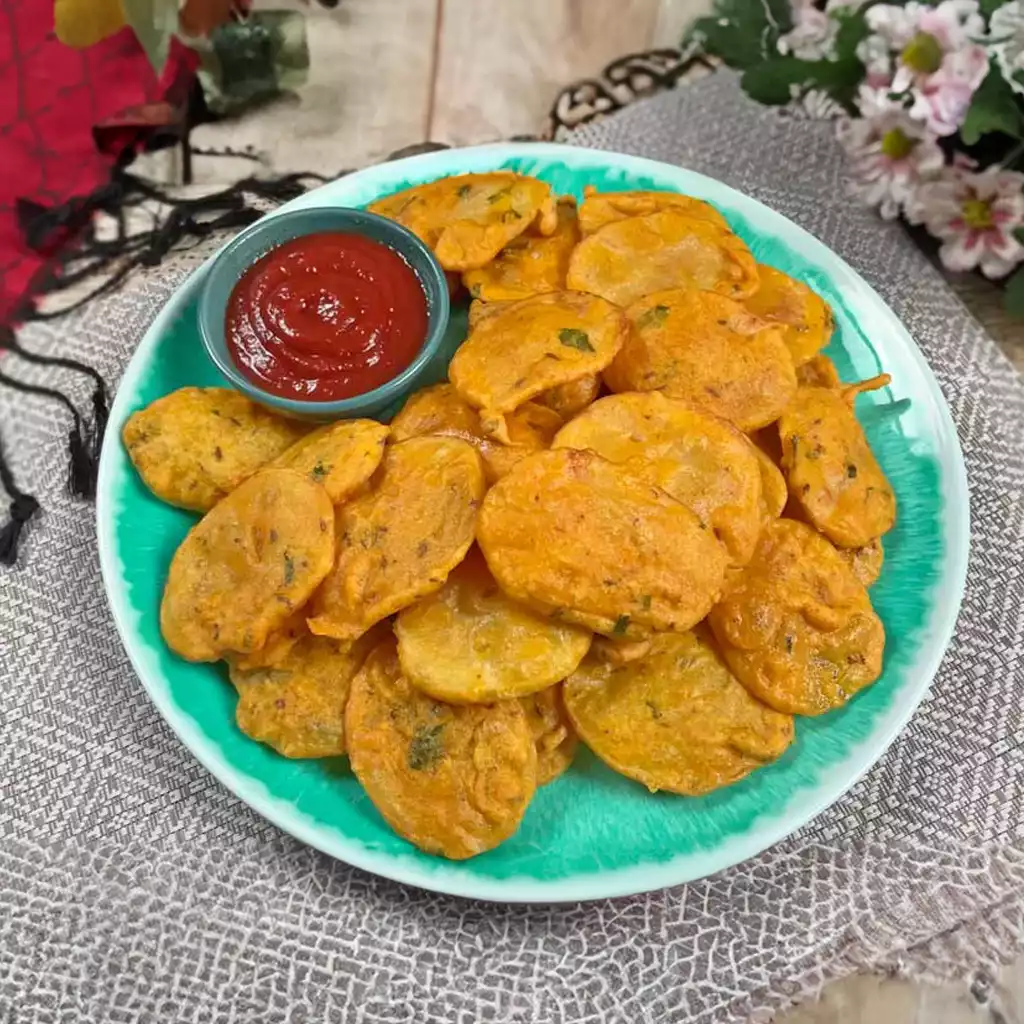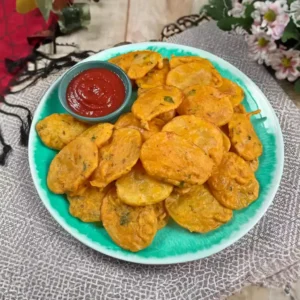
Welcome to my kitchen, where we’re diving into the delightful world of aloo pakora – crispy potato fritters that are the ultimate comfort food and snack.
Originating from the Indian subcontinent, aloo pakora is a popular street food and tea-time treat loved for its crispy exterior and soft, flavorful interior. Don’t be intimidated by the name; these fritters are easy to make, even for beginners in the kitchen.
With humble ingredients like potatoes, gram flour (besan), and a blend of spices, aloo pakora embodies simplicity yet packs a punch of flavor.
Its golden-brown, crispy texture is achieved through deep-frying, while the spices like turmeric powder, chilli powder, and cumin seeds infuse each bite with warmth and depth. A sprinkle of coriander adds freshness, enhancing the overall aroma and taste.
While traditionally enjoyed with a side of yogurt chutney or mint sauce, aloo pakora is versatile enough to pair with any dipping sauce or enjoy on its own. Whether you’re hosting a gathering or simply craving a savory snack, these crispy delights are sure to satisfy.
Expert Tip: To prevent the pakoras from sticking together while frying, add the coated potato slices to the hot oil one at a time, making sure they are not overcrowded in the pan.
Potatoes: Potatoes add a hearty texture and subtle sweetness to the pakoras. When sliced and coated in the batter, they become crispy on the outside and tender on the inside, creating a satisfying contrast of flavors and textures.
Gram Flour (Besan): Gram flour, also known as besan, acts as the binding agent in this recipe, helping to create a crispy coating around the potatoes when fried. It adds a nutty flavor and a golden color to the pakoras, making them visually appealing and delicious.
Turmeric Powder (Haldi): Turmeric powder not only imparts a vibrant yellow color to the pakoras but also adds a warm, earthy flavor to the dish. It also offers various health benefits, thanks to its anti-inflammatory and antioxidant properties.
Chilli Powder: Chilli powder adds a spicy kick to the pakoras, balancing out the other flavors in the dish. Adjust the amount according to your preference to control the level of heat in the pakoras.
Salt: Salt enhances the overall taste of the pakoras, bringing out the flavors of the other ingredients. It also helps to season the potatoes and the batter, ensuring that each bite is perfectly seasoned.
Crushed Chillies: Crushed chillies add an extra layer of heat and flavor to the pakoras, intensifying the spiciness of the dish. They also provide a subtle crunch, adding texture to the fritters.
Cumin Seeds (Jeera): Cumin seeds lend a warm, aromatic flavor to the pakoras, complementing the other spices in the dish. They add a hint of earthiness and depth to the batter, enhancing its overall complexity.
Dried Fenugreek Leaves (Methi): Dried fenugreek leaves contribute a unique, slightly bitter flavor to the pakoras, balancing out the richness of the potatoes and spices. They also add a subtle herbal aroma, enhancing the overall aroma of the dish.
Coriander: Fresh coriander leaves add a burst of freshness to the pakoras, brightening up the flavors and adding a pop of color. They also provide a mild, citrusy flavor that complements the other ingredients in the dish.
Expert Tip: When mixing the batter, start by adding water in small increments. This allows you to control the consistency and ensure that the batter is not too thin or too thick.
Expert Tip: A good way to test the oil temperature is by dropping a small piece of batter into the oil; if it sizzles and rises to the surface immediately, the oil is ready.
Yes, you can use any type of potato for this recipe. However, I recommend using starchy potatoes like russet or Yukon Gold for the best results. They have a fluffy texture that crisps up nicely when fried.
Yes, you can make the batter ahead of time and store it in the fridge for up to a day. Just make sure to cover it tightly with plastic wrap or transfer it to an airtight container to prevent it from drying out. Give it a good stir before using it to ensure that the ingredients are evenly distributed.
While traditionally aloo pakoras are deep-fried for that crispy texture, you can certainly try baking them for a healthier option. Preheat your oven to 400°F (200°C), place the coated potato slices on a lined baking sheet, and bake for about 20-25 minutes, flipping halfway through, until they are golden brown and crispy.
To test if the oil is hot enough, drop a small piece of batter into the oil. If it sizzles and rises to the surface immediately, the oil is ready for frying. Make sure the oil is not too hot, as it can cause the pakoras to brown too quickly on the outside while remaining undercooked on the inside.
Yes, you can freeze leftover aloo pakoras for later enjoyment. Allow them to cool completely, then place them in a single layer on a baking sheet and freeze until firm. Once frozen, transfer them to a resealable plastic bag or airtight container and store them in the freezer for up to 2 months. Reheat them in a preheated oven at 350°F (175°C) for about 10-15 minutes until heated through and crispy.
Here are some more recipes for you to enjoy! If you my recipes don’t forget to rate and leave a comment.
If you have any recipe suggestions, please do not hesitate to ask me. A great way to stay in contact with me is through Instagram, Facebook, Twitter and YouTube. Don’t forget to tag me @CookwithNabeela in your recipe photos!

Subscribe now to receive my latest recipes directly in your inbox. Stay up-to-date and never miss out!

I love to cook! I want to share with you my favourite, delicious family-friendly recipes. I want to inspire you to create fantastic food for your family every day.
Latest comments (2)
My new go to aloo pakora recipe! Absolutely love it and it’s so SIMPLE and EASY to make!
Thank you so much for trying out my recipe!